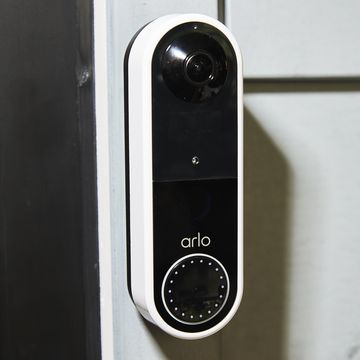We worked with National Instruments, an industrial test and measurement company, to create a data-logging device that could gauge and record vibration, temperature and orientation. Here's our package at the end of its journey.
A few years ago, Popular Mechanics shipped a custom-built gaming PC—a rather heavy and cumbersome beast—to a New Hampshire woman who'd won it in a sweepstakes. The computer arrived in pieces, delivering a crushing blow, so to speak, to the nice lady as well as to the PM staffers who'd built the computer. Even though we made good by reconstructing the PC and driving it to her doorstep, I still shudder at the memory of the gory photos she sent us of the shattered machine.
The overnight-shipping industry is a modern technological and logistical wonder, but it still can inflict medieval damage on parcels. Everyone has at one time or another received a dented, torn or otherwise mutilated package. And after our PC-shipping incident, I felt a sense of professional duty to find a way to get inside a package, as it were, and quantify the abuse it endures. Since my life insurance would become null and void if I attempted to ship myself, I needed a technological solution.
This sort of tech exists. Last fall, FedEx introduced a service for critical packages called SenseAware, which tracks vibration, g-force, orientation, temperature and other factors. But I didn't want to use SenseAware for the test because it's unavailable to the general public—and besides, I had a covert mission in mind.
I called up a contact at National Instruments—an innovative manufacturer of industrial control equipment and software, based in Austin, Texas—and presented a challenge: Could the company help me disguise vibration sensors inside a package that I could secretly ship around the country? I soon got a call from National Instruments engineers Kelly Rink, Jamie Brettle and Rick Kuhlman, who agreed to build for me a self-powered data logger equipped with an ARM microcontroller evaluation board, a three-axis accelerometer and a massive Energizer Energi To Go XP18000 battery.
The device they created was capable of measuring acceleration, orientation and temperature. But the task wasn't a slam-dunk. "Having a processor constantly awake and writing to an SD card takes a toll on a battery," Brettle says. "But by modifying our LabVIEW code, we were able to put the processor to sleep and selectively write to the SD card. That got us 74 hours of battery life." That's enough juice to gather data from a three-day trip. We were in business.
The Plan
I mapped out for our package a tour of the United States, starting and ending at Popular Mechanics's home office, in New York City, with stops at our West Coast headquarters, in Santa Monica, Calif., and National Instruments', in Austin. At each stop, the data was uploaded from a micro SD card, the battery recharged and the package sent on its way. The parcel was shipped a dozen times (we had neither the time nor the budget to make the hundreds of trips necessary for statistical significance), a modest experiment to see how the device performed and gather enough data to draw broad conclusions. Our targets—FedEx, UPS and the U.S. Postal Service—were unaware of the test. As we went along, we changed up a few variables to see if the treatment of our package changed as well. Was overnight shipping more or less violent than three-day? Did marking the package "Fragile" or "This Side Up" ensure more careful treatment?
Before the first journey, the National Instruments engineers collected baseline g-force readings. "We dropped the package from different heights, kicked it around our building, ran down the stairs with it in a backpack and took it on a car ride—giving real-world meaning to how many g's the package endured," says Kuhlman. The findings: A moderate jostle exerts 2 g's, while a 2.5-foot drop registers 6 g's; we set the latter as our limit for rough treatment. "Our co-workers thought we were a bit odd," says Brettle, "but we assured them it was all in the name of science."
The Results
So which company treats your packages with the most tender loving care? After crunching the data and averaging the number of spikes recorded by each carrier on each trip, we found that the USPS has the gentlest touch, with a per-trip average of 0.5 acceleration spikes over 6 g's. FedEx and UPS logged an average of three and two big drops per trip, respectively (see graph, next page).
Given those results, we were a little surprised to find that the USPS flipped over its Express Mail packages an awful lot, averaging 12.5 position changes per trip. Meanwhile, FedEx averaged seven position changes, and UPS had an average of four.
All three carriers did a good job at maintaining a stable temperature, but FedEx nabbed the top rating, with an average change of only 26.01 degrees, compared with 26.8 degrees for UPS and almost 32 degrees for the USPS. But the maximum temperatures our package experienced were within 2 degrees, and at no time did a temperature register above 80 degrees or below 47 degrees.
One disheartening result was that our package received more abuse when marked "Fragile" or "This Side Up." The carriers flipped the package more, and it registered above-average acceleration spikes during trips for which we requested careful treatment.
How the Carriers Performed
How does the data stack up? In our modest experiment—12 trips, three carriers, three cities—FedEx delivered the most big bumps, with an average of three acceleration spikes over 6 g's (equivalent to a 2.5-foot drop) per trip. The USPS was the gentlest yet also the most active handler, with an average 12.5 position changes per trip. UPS was tops at keeping our package upright.
Just Asking
When we were done, I called the carriers for comment. All described the shock-absorbing technologies used in their sorting facilities, and one spokesperson felt compelled to say that the shipping industry is an "industrial" environment. I was surprised to learn that, although the USPS uses its own sorting and delivery systems, Express Mail flies via FedEx. So our package experienced both the most and the least abuse while on the same airline. This raised an unanswerable question: Does the USPS have white-glove handling that offsets FedEx's turbulent planes, or did our package just happen to catch a few smooth rides?
One bright finding of our test was the reliability of the service. In fact, several of our three-day deliveries arrived early. Quick delivery is what you expect—and pay for—but is gentle treatment as well too much to ask for? Kuhlman said it best in an e-mail to me: "Shipping overnight is expensive. For the price you pay, I feel like they should be rushing the package on a silver platter in a little butler's tuxedo." Thanks to the test, I have an answer for Kuhlman: Dream on.
>
A Day in the Life
of a Package >>>
A Day in the Life of a Package
What does it feel like to be a package traveling across the U.S.? Our test parcel logged 12 trips from New York City to Santa Monica, Calif., to Austin, Texas. This coast-to-coast journey was a good example of both quick service and rough handling, with four acceleration spikes over our designated 6-g threshold. Here, we've correlated the time code from our sensor with FedEx's tracking info.














